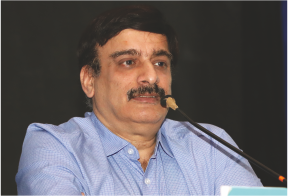The session highlighted the need for a robust and integrated logistics infrastructure and how various stakeholders can contribute towards it.
The second edition of SLS Hyderabad was organised on August 3 at Park Hyatt. Setting the tone for day-long deliberations, Ramprasad, Editor-in-Chief, Maritime Gateway said, the state ranks on 5th position in international exports from the country with bulk drugs accounting for the large chunk of exports moving out from the state. Hyderabad, Rangareddy, Medchal and Sangareddy have been the major growth clusters in the state. Taking note of the discrepancies in logistics he said, even though, JNPT is far off from Telangana, but still about 80 per cent of the cargo moves through this major port.
 Anil Kumar Jain, IRS, Principal Commissioner, Hyderabad Customs Commissionerate, recommended the trade to opt for AEO, as many of the global traders prefer to trade with AEO accredited businesses. GST has brought in another paradigm shift in the way trade works and even though certain glitches remain in the refund process, but they will soon be sorted out.
Anil Kumar Jain, IRS, Principal Commissioner, Hyderabad Customs Commissionerate, recommended the trade to opt for AEO, as many of the global traders prefer to trade with AEO accredited businesses. GST has brought in another paradigm shift in the way trade works and even though certain glitches remain in the refund process, but they will soon be sorted out.
Pharma products need to be transported quickly and safely, hence efficient logistics is critical emphasised, R K Agarwal, Senior Vice President, BDMA & MD, Nakoda Chemicals Ltd, bringing to the fore the challenges faced by pharma sector. First challenge is lack of coordination: Since many people are involved in the value chain, so there is utmost need for coordination, else there will be pilferage and quality of the product may degenerate. This lack of coordination also gives an edge to manufacturers of counterfeit drugs to take over during transit.
Second biggest challenge is environmental control: Storage or logistics cold chains need to be customised to maintain different temperature ranges for different products. The third challenge is warehousing management: Pharma industry should recommend specifications for developing warehousing structures, tools and equipment to ensure the products are kept at optimum temperature conditions during storage and transit.
The clearing operations at the airports are highly streamlined, but many times the samples need to be drawn at the airport to verify the authenticity of the drugs. This calls for maintaining controlled temperature rooms at the airports, else there will be chances of contamination. Pharma products should never be opened in a normal warehouse without proper air control and ventilation. In India air ports are slightly better than the seaports. Especially the dry port in Hyderabad has inadequate handling procedures.
“Telangana Chambers of Commerce has announced to form a separate committee for logistics,” informed M Venkateshwarlu, President, Telangana Chambers of Commerce and Industry. He urged the industry to share their recommendations for consideration by the committee.
“Customs has transformed from being a regulatory enforcement agency to become a facilitating agency,” said N Priyanka, IRS, Deputy Commissioner Customs, Hyderabad Customs Commissionerate. The latest ESanchit enables entire documentation to be given on a paperless platform. Business entities with atleast 25 bills of entries per anum are entitled to enrol for AEO, wherein the entities having strong compliance system and internal controls are being offered deferred duty payments, DPD, faster clearances, nil or negligible examination or assessment, bank guarantee requirements have been reduced.
“Container trade growth on the east coast was more than 30 per cent last year. Krishnapatnam Port alone has posted about 90 per cent growth in the last two years,” revealed Anil Yendluri, Director & CEO, Krishnapatnam Port Company Ltd. In 2016-17, the port grew at around 115 per cent and in 2017-18 the port posted a growth of 80 per cent. This growth underscores the changing trade patterns – The actual growth at the global level is happening within Asia, Africa and among these regions. When we say that 80-90 per cent of cargo from Hyderabad is moving through JNPT, it means the trade is not using the most optimum route available on the east coast resulting in higher logistics cost. they need to explore opportunities on the east coast, opined Anil.







